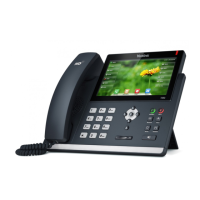Administrator’s Guide for SIP-T2 Series/T19(P) E2/T4 Series/CP860 IP Phones
580
Outgoing Call When the Working Server Connection Fails
When a user initiates a call, the IP phone will go through the following steps to connect
the call:
1. Sends the INVITE request to the primary server.
2. If the primary server does not respond correctly to the INVITE, then tries to make the
call using the secondary server.
3. If the secondary server is also unavailable, the IP phone will try the fallback server
until it either succeeds in making a call or exhausts all servers at which point the
call will fail.
At the start of a call, server availability is determined by SIP signaling failure. SIP
signaling failure depends on the SIP protocol being used as described below:
If TCP is used, then the signaling fails if the connection or the send fails.
If UDP is used, then the signaling fails if ICMP is detected or if the signal times out. If
the signaling has been attempted through all servers in the list and this is the last
server, then the signaling fails after the complete UDP timeout defined in RFC 3261.
If it is not the last server in the list, the maximum number of retries depends on the
configured retry count.
Procedure
SIP Server Domain Name Resolution can be configured using the configuration files or
locally.
Configure the transport type on
the IP phone.
Parameters:
account.X.sip_server.Y.transport_t
ype
account.X.naptr_build
Configure the transport type on
the IP phone.
Navigate to:
http://<phoneIPAddress>/servlet
?p=account-register&q=load&ac
c=0
Details of Configuration Parameters:
account.X.sip_server.Y.transport_type
(X ranges from 1 to 16, Y ranges from 1 to 2)

